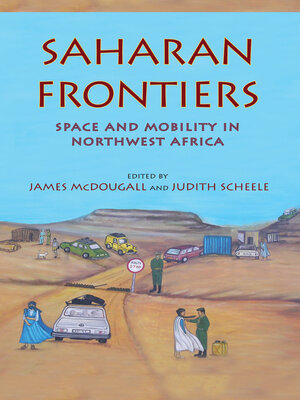Saharan Frontiers
ebook ∣ Space and Mobility in Northwest Africa · Public Cultures of the Middle East and North Africa
By James McDougall

Sign up to save your library
With an OverDrive account, you can save your favorite libraries for at-a-glance information about availability. Find out more about OverDrive accounts.
Find this title in Libby, the library reading app by OverDrive.



Search for a digital library with this title
Title found at these libraries:
| Library Name | Distance |
|---|---|
| Loading... |
"Makes a compelling case for the importance of Saharan history, both in its own right and in its articulations with the histories of other regions." —American Ethnologist
The Sahara has long been portrayed as a barrier that divides the Mediterranean world from Africa proper and isolates the countries of the Maghrib from their southern and eastern neighbors. Rather than viewing the desert as an isolating barrier, this volume takes up historian Fernand Braudel's description of the Sahara as "the second face of the Mediterranean." The essays recast the history of the region with the Sahara at its center, uncovering a story of densely interdependent networks that span the desert's vast expanse. They explore the relationship between the desert's "islands" and "shores" and the connections and commonalities that unite the region. Contributors draw on extensive ethnographic and historical research to address topics such as trade and migration; local notions of place, territoriality, and movement; Saharan cities; and the links among ecological, regional, and world-historical approaches to understanding the Sahara.
Contributions by Dida Badi, Julien Brachet, Armelle Chopin, Charles Grémont, Peregrine Horden, Olivier Leservoisier, Laurence Marfaing, E. Ann McDougall, Abderrahmane Moussaoui, Mohamed Oudada, Fatma Oussedik, and Katia Schörle
"A compilation of coherent, well-structured case studies addressing highly significant issues for the contemporary Sahara . . . a groundbreaking study." —Social Anthropology
"Altogether, this book is highly recommendable. Its key contribution is in teaching us to conceive of the Sahara not as a region clearly defined by natural features, but as a space that exists, extends, and expands according to its vibrant human interconnectedness." —Journal of the Royal Anthropological Institute
The Sahara has long been portrayed as a barrier that divides the Mediterranean world from Africa proper and isolates the countries of the Maghrib from their southern and eastern neighbors. Rather than viewing the desert as an isolating barrier, this volume takes up historian Fernand Braudel's description of the Sahara as "the second face of the Mediterranean." The essays recast the history of the region with the Sahara at its center, uncovering a story of densely interdependent networks that span the desert's vast expanse. They explore the relationship between the desert's "islands" and "shores" and the connections and commonalities that unite the region. Contributors draw on extensive ethnographic and historical research to address topics such as trade and migration; local notions of place, territoriality, and movement; Saharan cities; and the links among ecological, regional, and world-historical approaches to understanding the Sahara.
Contributions by Dida Badi, Julien Brachet, Armelle Chopin, Charles Grémont, Peregrine Horden, Olivier Leservoisier, Laurence Marfaing, E. Ann McDougall, Abderrahmane Moussaoui, Mohamed Oudada, Fatma Oussedik, and Katia Schörle
"A compilation of coherent, well-structured case studies addressing highly significant issues for the contemporary Sahara . . . a groundbreaking study." —Social Anthropology
"Altogether, this book is highly recommendable. Its key contribution is in teaching us to conceive of the Sahara not as a region clearly defined by natural features, but as a space that exists, extends, and expands according to its vibrant human interconnectedness." —Journal of the Royal Anthropological Institute







